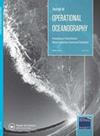用高分辨率洋流预测溢油轨迹
IF 2.4
3区 地球科学
Q4 METEOROLOGY & ATMOSPHERIC SCIENCES
引用次数: 5
摘要
从海洋环流模型中模拟的海流和海面风通常用于模拟溢油轨迹模型。海洋环流是决定泄漏海洋污染物漂移的关键因素。本文给出了两个海洋模型在洋流的作用下,对溢油漂移模式的模拟。商船(MV) Rak于2011年8月4日在东经72.4865°,北纬18.7715°沉没。根据印度海岸警卫队提供的信息,2011年8月5日至8月12日期间,约有122.5吨燃料油从该船泄漏。利用通用NOAA业务模拟环境(GNOME)的溢油轨迹模型,模拟了2011年8月5日1000时至2011年8月12日1300时从MV Rak的溢油漂移模式。GNOME受到来自欧洲中期天气预报中心(ECMWF)的风和来自印度洋预报系统(INDOFOS)和高分辨率业务海洋预报和再分析系统(HOOFS)的洋流的推动。我们发现,与使用INDOFOS洋流时相比,在HOOFS洋流强迫下获得的油漂移模式与实际轨迹更吻合。本文章由计算机程序翻译,如有差异,请以英文原文为准。
Oil spill trajectory prediction with high-resolution ocean currents
ABSTRACT Simulated ocean currents from ocean circulation models along with the surface winds are generally used to force an oil spill trajectory model. Ocean circulation is a key factor in determining the drift of the spilled marine pollutants. The simulations of the drift pattern of spilled oil, when forced by the ocean currents from two ocean models, are presented here. Merchant Vessel (MV) Rak sunk at 72.4865°E, 18.7715°N, on 4 August 2011. As per the information from Indian Coast Guard, approximately 122.5 tons of fuel oil was spilled from the vessel from 5 August 2011 to 12 August 2011. An oil spill trajectory model, General NOAA Operational Modeling Environment (GNOME), was used to simulate the oil drift pattern from MV Rak from 1000 hours of 5 August 2011 to 1300 hours of 12 August 2011. GNOME was forced with winds from European Centre for Medium Range Weather Forecast (ECMWF) and ocean currents from Indian Ocean Forecasting System (INDOFOS) and High-resolution Operational Ocean Forecasting and reanalysis System (HOOFS). We found that the oil drift pattern obtained when forced with ocean currents from HOOFS was in better agreement with the actual track, compared to the one obtained while using INDOFOS currents.
求助全文
通过发布文献求助,成功后即可免费获取论文全文。
去求助
来源期刊
CiteScore
7.50
自引率
9.70%
发文量
8
审稿时长
>12 weeks
期刊介绍:
The Journal of Operational Oceanography will publish papers which examine the role of oceanography in contributing to the fields of: Numerical Weather Prediction; Development of Climatologies; Implications of Ocean Change; Ocean and Climate Forecasting; Ocean Observing Technologies; Eutrophication; Climate Assessment; Shoreline Change; Marine and Sea State Prediction; Model Development and Validation; Coastal Flooding; Reducing Public Health Risks; Short-Range Ocean Forecasting; Forces on Structures; Ocean Policy; Protecting and Restoring Ecosystem health; Controlling and Mitigating Natural Hazards; Safe and Efficient Marine Operations

 求助内容:
求助内容: 应助结果提醒方式:
应助结果提醒方式:


